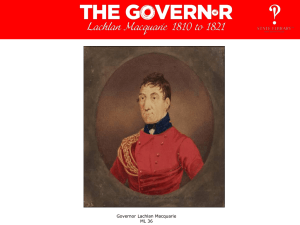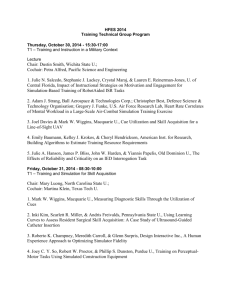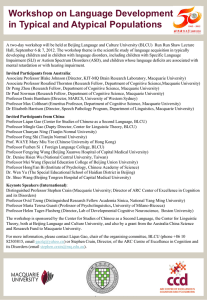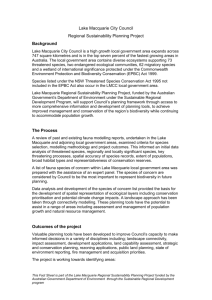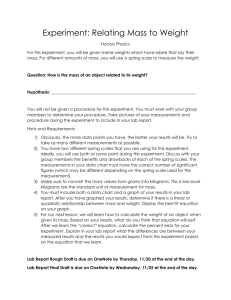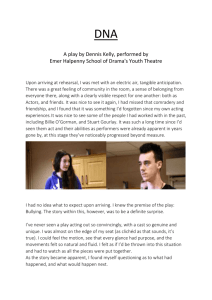proforma - Curriculum Support
advertisement
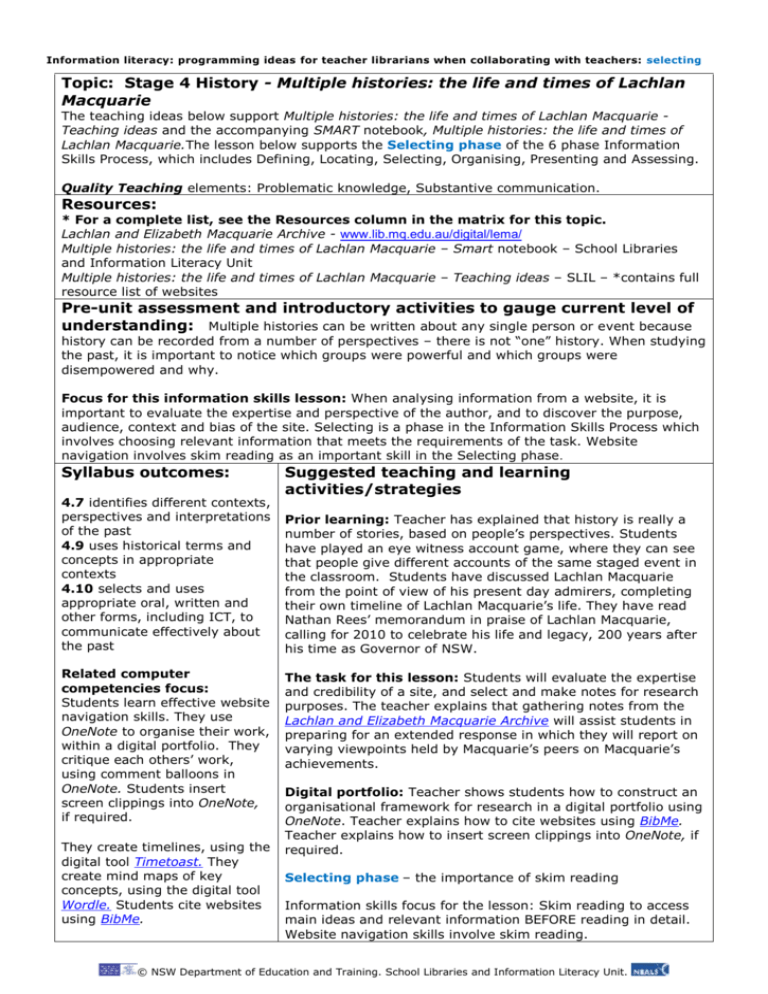
Information literacy: programming ideas for teacher librarians when collaborating with teachers: selecting Topic: Stage 4 History - Multiple histories: the life and times of Lachlan Macquarie The teaching ideas below support Multiple histories: the life and times of Lachlan Macquarie Teaching ideas and the accompanying SMART notebook, Multiple histories: the life and times of Lachlan Macquarie.The lesson below supports the Selecting phase of the 6 phase Information Skills Process, which includes Defining, Locating, Selecting, Organising, Presenting and Assessing. Quality Teaching elements: Problematic knowledge, Substantive communication. Resources: * For a complete list, see the Resources column in the matrix for this topic. Lachlan and Elizabeth Macquarie Archive - www.lib.mq.edu.au/digital/lema/ Multiple histories: the life and times of Lachlan Macquarie – Smart notebook – School Libraries and Information Literacy Unit Multiple histories: the life and times of Lachlan Macquarie – Teaching ideas – SLIL – *contains full resource list of websites Pre-unit assessment and introductory activities to gauge current level of understanding: Multiple histories can be written about any single person or event because history can be recorded from a number of perspectives – there is not “one” history. When studying the past, it is important to notice which groups were powerful and which groups were disempowered and why. Focus for this information skills lesson: When analysing information from a website, it is important to evaluate the expertise and perspective of the author, and to discover the purpose, audience, context and bias of the site. Selecting is a phase in the Information Skills Process which involves choosing relevant information that meets the requirements of the task. Website navigation involves skim reading as an important skill in the Selecting phase. Syllabus outcomes: 4.7 identifies different contexts, perspectives and interpretations of the past 4.9 uses historical terms and concepts in appropriate contexts 4.10 selects and uses appropriate oral, written and other forms, including ICT, to communicate effectively about the past Related computer competencies focus: Students learn effective website navigation skills. They use OneNote to organise their work, within a digital portfolio. They critique each others’ work, using comment balloons in OneNote. Students insert screen clippings into OneNote, if required. They create timelines, using the digital tool Timetoast. They create mind maps of key concepts, using the digital tool Wordle. Students cite websites using BibMe. Suggested teaching and learning activities/strategies Prior learning: Teacher has explained that history is really a number of stories, based on people’s perspectives. Students have played an eye witness account game, where they can see that people give different accounts of the same staged event in the classroom. Students have discussed Lachlan Macquarie from the point of view of his present day admirers, completing their own timeline of Lachlan Macquarie’s life. They have read Nathan Rees’ memorandum in praise of Lachlan Macquarie, calling for 2010 to celebrate his life and legacy, 200 years after his time as Governor of NSW. The task for this lesson: Students will evaluate the expertise and credibility of a site, and select and make notes for research purposes. The teacher explains that gathering notes from the Lachlan and Elizabeth Macquarie Archive will assist students in preparing for an extended response in which they will report on varying viewpoints held by Macquarie’s peers on Macquarie’s achievements. Digital portfolio: Teacher shows students how to construct an organisational framework for research in a digital portfolio using OneNote. Teacher explains how to cite websites using BibMe. Teacher explains how to insert screen clippings into OneNote, if required. Selecting phase – the importance of skim reading Information skills focus for the lesson: Skim reading to access main ideas and relevant information BEFORE reading in detail. Website navigation skills involve skim reading. © NSW Department of Education and Training. School Libraries and Information Literacy Unit. Related information skills focus area: Using the Lachlan and Elizabeth Macquarie Archive - the teacher models website navigation skills for students. Selecting Website navigation skills Students use the following: Students make decisions in answer to these questions: What information do I really need to use? What information can I leave out? How relevant is the information I have found? How credible is the information I have found? How will I record the information I need? * See the matrix for more information about the Selecting phase. o o o o o o o o menus navigation bars contents listings index or glossary webpage titles subheadings images and captions fact boxes to assist in SELECTING information which answers the specific research question they have been set. Teacher teaches students to check the credibility and expertise of the website’s creator by looking at the ABOUT section of the site. Website evaluation checklist o o o o o o o o Author/organisation – expert? Purpose/funding – stated? Aimed at which audience? Bias/neutrality – clear to the reader? [Are other viewpoints mentioned if the topic is controversial?] Sources/statistics – primary sources? secondary sources? referenced? Quality of ideas and information? Website layout – easy to navigate? Page layouts – clear, uncluttered, use visual information and useful headings? Up to date information? Teacher explains fact/opinion difference. Students and teacher discuss examples of cat and opinion – a distinguishing game. Rewording methods – transforming information into knowledge Form students into groups, each group will report back about one section they have researched using the LEMA Sites2See. Once students have selected their information from the Lachlan and Elizabeth Macquarie Archive Sites2See – on TaLe, at, they save it in OneNote, then change the wording so that it becomes their “own”. The teacher shows students how to make notes and reword the original information, using their own words. Teacher demonstrates to students how to paraphrase, rearrange sentences, rebuild from key words and substitute synonyms. Teacher explains that transforming knowledge into one’s own words 1) transfers it into one’s long term memory, 2) builds personal understanding and 3) avoids plagiarism © NSW Department of Education and Training. School Libraries and Information Literacy Unit. Post unit assessment to determine progress towards stated outcomes Assessment for learning Students analyse sources and evaluate their own and their peers’ work in their digital portfolios, using OneNote comment balloons. Task at end of lesson sequence Students write about the varying perspectives on Lachlan Macquarie’s life, held by his peers. © NSW Department of Education and Training. School Libraries and Information Literacy Unit.
